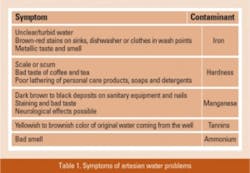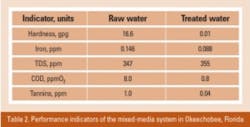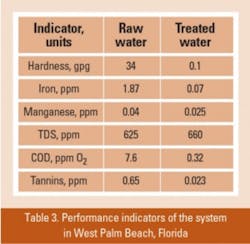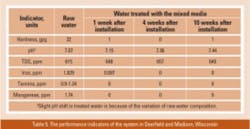The U.S. Environmental Protection Agency (EPA) estimates that about 15 percent of Americans receive drinking water from private wells. Well water is better protected from human activity, but its mineral content varies.
According to water quality statistics, such as United Nations Global Environment Monitoring System Water Programme, and other experts’ opinions, five major well water problems are hardness, iron, manganese, tannins (organic molecules causing water discoloration) and ammonium. One system can remove all five.History of invention
In 1998, European professionals used a traditional, multistage process to remove the contaminants. The most popular sequence was:
- Catalytic media to remove iron and manganese
- Ion exchange resin for softening
- Activated carbon for tannin removal
- Adsorbent to remove ammonium
The goal was to combine all the technologies required to treat the contaminants in Table 1 in one process. After years of research and tests, a product was developed to efficiently remove all impurities in one system that functions similarly to a traditional water softener.
How it treats
The softening material used in the technology contains five active components that stratify into four layers in the mineral tank after the first backwash. Each component has a unique function — oxidation-adsorption of iron and manganese, retention of tannins, and hardness and ammonium removal. Regeneration is simple, with pelletized salt at a rate of 30 percent less than for a normal softener.
The process sounds simple, but the trick is in the surface chemistry of the components. Two are present. One is a copolymer with a modified surface, where charged and complexation groups are immobilized. It binds manganese and iron ions and catalyzes the oxidation of the latter. The other is two types of functional groups that bind natural organics and releases them during regeneration.
Certified safety and international recognition
This media mix has been successfully applied in East Europe since 1999. It was first used in the Western European market in 2005 and became popular in the U.S. in 2013. The technology is effective in residential as well as small and large commercial applications.
US field testsA recent series of field tests in the U.S. confirm the applicability of the technology on well water in the states. Several hundred systems have been successfully installed in South Florida and have performed well given Florida’s challenging water conditions. Few results have been published because tests are ongoing.
Field Test 1 – Okeechobee
One field test was conducted at an Okeechobee, Florida, ranch, where the main problem was high tannin concentration. The system had never been tested in South Florida’s yellowish water and high temperatures, but performance was good (see Table 2), yielding a 96 percent rejection of tannins along with iron removal and softening.Field Test 2 – West Palm Beach
Another example is a West Palm Beach, Florida, residence. A private home was fed by water highly concentrated in hardness, iron and tannins. A conventional, multistage water purification system was previously installed. A single unit replaced the aeration tank, manganese greensand, softener and active carbon filter. The technology performed well (see Table 3).
Field Test 3 – Deerfield and Madison, Wisconsin
The first field test results came from Deerfield and Madison, Wisconsin, in which raw water with hardness, iron, tannins and manganese was treated. The results (see Table 5) show the effective softening and removal of iron, tannins and manganese.
Comparison with conventional approachThe mixed-media technology can be compared to the conventional approach. This includes pH correction or aeration, catalytic iron removal, softening system, tannin removal system with activated carbon or SBA resin. In general, this approach is more complicated, requires detailed raw water quality investigation and sophisticated system installation techniques, and creates problems during startup and maintenance. It is also expensive (see Table 4).
Conclusion
Field studies and research reveal that the mixed-media technology provides technical advantages, simplicity and savings for complex water purification.
Resources- U.S. Environmental Protection Agency, www.water.epa.gov.
- "Drinking Water from Household Wells," EPA 816-K-02-003, January 2002.
- Global Environment Monitoring System, www.gemstat.org.
- "Drinking Water Health Advisory for Manganese," EPA, EPA-822-R-04-003, January 2004.
Andrey Mitchenko is an international researcher and interpreter. He is CEO and co-founder of ECOSOFT, an international water purification company with manufacturing facilities in Germany and Ukraine.





